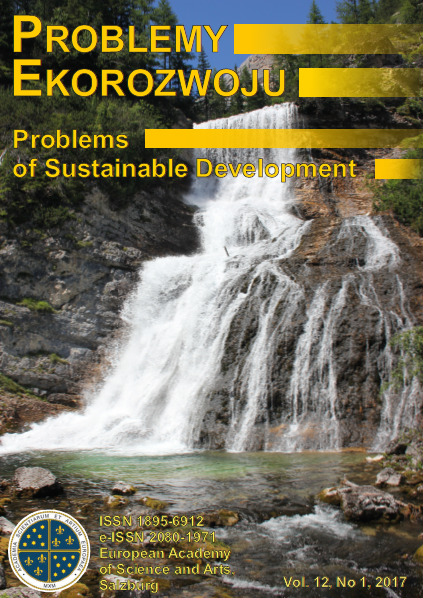Influence of RES Integrated Systems on Energy Supply Improvement and Risks
Article Sidebar
Open full text
Issue Vol. 12 No. 1 (2017)
-
The Effect of Environmental Innovation on Employment Level: Evidence from China’s Manufacturing Industries
Wei Yu, Huifang Yu7-14
-
Climatic Migrations – Consequences of Upsetting Environmental Balance and a of Flaws in Human Protection by International Law
Piotr Krajewski15-20
-
General Social Survey and Sustainable Development. Methodological and Empirical Aspects
Paweł Rydzewski21-29
-
Tackling Sustainability from a Systemic Perspective: A Contextualized Approach
Horatiu Dragomirescu, Lino Bianco41-54
-
Social Responsibility, Internal Governance and Manufacturing Growth
Yuhong Cao, Jianxin You, Yongjiang Shi, Wei Hu41-54
-
Prosumption as a Factor of Sustainable Development
Michał Czuba55-61
-
A Three-dimensional Aproach in Education for Sustainable Future
Živilė Sederevičiūtė-Pačiauskienė, Viktorija Žilinskaitė-Vytienė, Ilona Valantinaitė63-69
-
Sustainable Development of a City: Systemic Approach
Lidia Mierzejewska71-78
-
Rationalisation of Investment Decisions in the Sustainable Management of Urban Development – is a New Paradigm Needed?
Anna Wojewnik-Filipkowska79-90
-
Effect of Drilling for Shale Gas on the Quality of Atmospheric Air
Jan Macuda, Marek Bogacki, Jakub Siemek91-100
-
Model-Driven Engineering and Creative Arts Approach to Designing Climate Change Response System for Rural Africa: A Case Study of Adum-Aiona Community in Nigeria
Emmanuel Okewu, Sanjay Misra, Jonathan Okewu101-116
-
Sustainable Development in the Context of the Integral Approach of the Human Person Guido Gatti
Jakub Bartoszewski, Bartłomiej Skowroński, Peter Papšo117-121
-
Influence of RES Integrated Systems on Energy Supply Improvement and Risks
Vladimir Ivanovich Velkin, Sergei Evgenevich Shcheklein123-129
-
Issues of Sustainable Development in the Light of a GIS-based Assessment of the Geochemical State of the Aquatic Environment
Katarzyna Rozpondek, Rafał Rozpondek131-137
-
Ecological Compensation Standard for Non-point Pollution from Farmland
Yin Zhang, Yujia Ji, Yuchen Zhou, Hua Sun139-146
-
Sustainable Landfilling as Final Step of Municipal Waste Management System
Marcin K. Widomski, Piotr Gleń, Grzegorz Łagód147-155
Archives
-
Vol. 14 No. 2
2019-07-01 20
-
Vol. 14 No. 1
2019-01-02 20
-
Vol. 13 No. 2
2023-10-15 22
-
Vol. 13 No. 1
2018-01-02 23
-
Vol. 12 No. 2
2017-07-03 18
-
Vol. 12 No. 1
2017-01-02 16
-
Vol. 11 No. 2
2016-07-01 17
-
Vol. 11 No. 1
2016-01-04 20
-
Vol. 10 No. 2
2015-07-01 17
-
Vol. 10 No. 1
2015-01-05 16
Main Article Content
Authors
Abstract
RES (renewable energy sources) plays a very important role in the context of sustainable development, as an alternative to fossil fuels and nuclear power.
This paper presents the description of a RES technology cluster – an integrated system, which consists of equipment using different types of RES. It demonstrates that the stochasticity of renewable energy input influences the energy supply reliability. The work considers the influence of diversification of different RES sources on the improvement of energy supply reliability and reduction of risks connected with energy loss. Based on mathematical simulation using the convex optimization method, the authors propose a novelty solution to determine the most effective equipment configuration of an integrated energy system – a RES cluster. Effective computer programs have been developed and registered in order to calculate the optimal integrated renewable energy system in the Russian Federation.
The optimization criterion is the minimal cost of generating 1kWh of electricity of the whole complex of renewable energy sources. The feature of calculating the optimal combination of renewable energy sources is based on the variance of random variables, climatic characteristics unlike average for the year. This approach improves the accuracy of calculations by 25-40%. This leads to a reduction in capital equipment costs and reducing the cost of production of 1kWh of electricity.
Keywords:
References
KNIGHT F., 1921, Risk, Uncertainty and Profit, Houghton Mifflin, Boston and New York.
BENDAT J., PIERSOL A., 1971, Random data: Analysis and measurement processes, Wiley Interscience, New York.
ESIPOV Y.V., SAMSONOV F.A., CHEREMISIN A.I., 2008, Monitoring and evaluation of system risks, Publishing house LKI, Moscow.
SHARPE W.F., 1963, A Simplified Model for Portfolio Analysis, in: Management Science, vol. 9(2), p. 277-293.
VELKIN V., 2013, The use of the graphical model for the RES cluster for determining the optimal composition of the equipment of renewable energy sources, in: World Applied Sciences Journal, vol. 29(9), p. 1343-1348.
TOBIN J., 1965, The Theory of Portfolio Selection, in: The Theory of Interest Rate, eds. Hahn F.N., Brechling F.R.P., Macmillan, London.
MARKOWITZ H.M., 1952, Portfolio selection, in: Journal of Finance, vol. 7(1), p. 77-91.
MARKOWITZ H.M., 1990, Mean-Variance Analysis in Portfolio Choice and Capital Markets, Blackwell, Cambridge, MA.
FULZELE J.B., DUTT S., 2012, Optimium Planning of Hybrid Renewable Energy System Using HOMER, in: International Journal of Electrical and Computer Engineering, vol. 2(1), p. 68-74.
LAKHOUA M.N., 2014, System Analysis of a Hybrid Renewable Energy System, in: International Journal of Electrical and Computer Engineering, vol. 4(3), p. 343-350.
Article Details
Abstract views: 45
License

This work is licensed under a Creative Commons Attribution-ShareAlike 4.0 International License.


